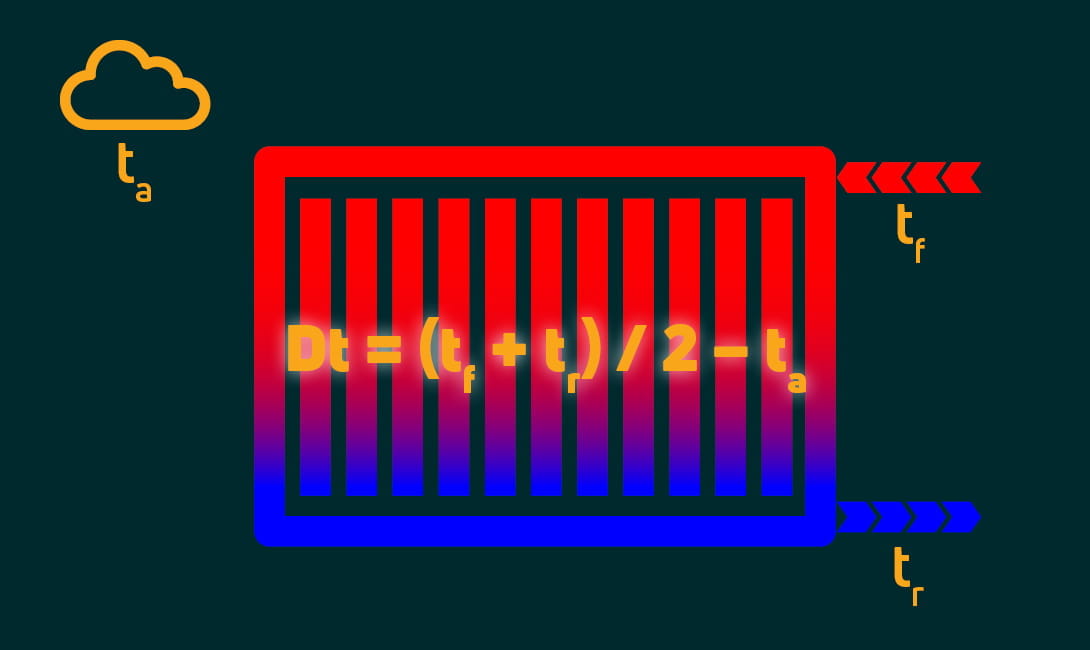- Hydronic heating
- Insights
- Radiators
- Underfloor heating
The importance of delta t in hydronic heating systems
What is delta t?
In general, the term delta t (Δt) refers to the temperature difference between 2 different measuring points. When talking about delta t with reference to radiators, there are 2 important temperature differences; before and after heat transfer. The delta t temperature difference is usually measured in Kelvin (K), which has the same scaling unit as the degree Celsius (°C). A temperature of 10 Kelvin is therefore equivalent to a difference of 10 degrees Celsius.Heating medium temperature
Other related key concepts are the heating medium temperature and heating medium excess temperature. The heating medium temperature, or mean temperature, is the average water temperature in a heating system, based on the inflow and outflow water temperatures. Using the temperature difference between the flow and return temperature as well as the water mass flow rate, it’s easy to define the heat output with the following formula:
Q = ṁ * cp * Δt
In the formula the heat output (Q) equals the mass flow rate (ṁ) * the specific heat capacity of the water (cp) * the difference in temperature before and after heat transfer (Δt). This formula emphasises the importance of correctly setting the flow rate and temperature in order to optimise a hot water loop.
Heating medium excess temperature
The excess temperature of the heating medium is the temperature difference between the average heating medium temperature and the room temperature. The heat output of an individual heating surface can be calculated using the direct relationship between heat output and excess temperature. This applies to heat exchangers in general, but also specifically to radiators and radiant heating.
If, for example, the room temperature is 20°C and the average heating medium temperature inside the radiator is 70°C (75°C inlet water temperature and 65°C outlet water temperature), then the excess temperature delta t is 50K. The excess temperature of the heating medium is determined either arithmetically or logarithmically, with the arithmetic excess temperature being sufficient for rough calculations. The formula for this is:
Δt = (tf + tr) / 2 – ta
In the formula delta t equals the sum of the flow temperature (tf) and the return temperature (tr) divided by 2 minus the room air temperature (ta).
The figures in the example above are chosen deliberately as delta t50 is the current European standard for measurements of modern boilers and radiator systems.
Why is delta t important?
The excess temperature (delta t) is used to define a room’s heating load in combination with a radiator’s heat output. So, when installing or replacing radiators, it’s vital to use the correct system temperature, and thus also the heating medium excess temperature. This will ensure that the radiators are sized correctly for the room they are placed in and the heating system is able to sufficiently heat the space. It avoids under- or overheating and helps to optimise both energy efficiency and indoor climate comfort.
When comparing radiator outputs and prices, make sure to check which delta t is mentioned. This will allow for a correct comparison across a mix of product types.
Delta t50
As mentioned before, delta t50 is the current European testing standard for radiators. However, this doesn’t automatically mean that it should be used blindly. The right system temperatures depend on the building standard (e.g. year of construction, insulation standard, etc.) as well as the heat generator that’s being used (condensing boiler, heat pump, etc.). If the system temperatures change, for example when the heat generator is replaced, the radiator sizes must be reviewed and, if necessary, adjusted to the new system temperatures. The rule of thumb is: the lower the excess temperature of the heating medium, the larger the radiators should be.
The above explanations show the close relationship between the system temperature, the spread between flow and return temperature and the radiator performance. As soon as anything changes with regard to the flow rates or system temperatures, the radiators must be checked and replaced if necessary.
Read more about the link between a boiler replacement and the radiator system

